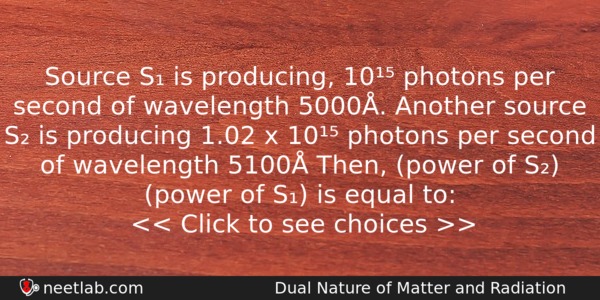| ⇦ | 
| ⇨ |
Source S₁ is producing, 10¹⁵ photons per second of wavelength 5000Å. Another source S₂ is producing 1.02 x 10¹⁵ photons per second of wavelength 5100Å Then, (power of S₂) (power of S₁) is equal to:
Options
(a) 1
(b) 1.02
(c) 1.04
(d) 0.98
Correct Answer:
1
Explanation:
energy emitted/sec by S₁, P₁ = n₁ hc / λ₁
energy emitted/sec by S₂, P₂ = n₂ hc / λ₂
P₂ / P₁ = n₂ / n₁ . λ₁ / λ₂
= 1.02 x 10¹⁵ / 10¹⁵ . 5000 / 5100 = 1.0
Related Questions: - A neutron moving with velocity v collides with a stationary particle
- In stretching a spring by 2 cm, energy stored is given by U. Had is been stretched
- The coefficient of mutual inductance of two coils is 6 mH. If the current flowing
- Light of wavelength λ is incident on slit of width d. The resulting diffraction
- Two electrons are separated by a distance of 1Å. What is the coulomb force between them?
Topics: Dual Nature of Matter and Radiation
(150)
Subject: Physics
(2479)
Important MCQs Based on Medical Entrance Examinations To Improve Your NEET Score
- A neutron moving with velocity v collides with a stationary particle
- In stretching a spring by 2 cm, energy stored is given by U. Had is been stretched
- The coefficient of mutual inductance of two coils is 6 mH. If the current flowing
- Light of wavelength λ is incident on slit of width d. The resulting diffraction
- Two electrons are separated by a distance of 1Å. What is the coulomb force between them?
Topics: Dual Nature of Matter and Radiation (150)
Subject: Physics (2479)
Important MCQs Based on Medical Entrance Examinations To Improve Your NEET Score
18000+ students are using NEETLab to improve their score. What about you?
Solve Previous Year MCQs, Mock Tests, Topicwise Practice Tests, Identify Weak Topics, Formula Flash cards and much more is available in NEETLab Android App to improve your NEET score.
Share this page with your friends

Leave a Reply